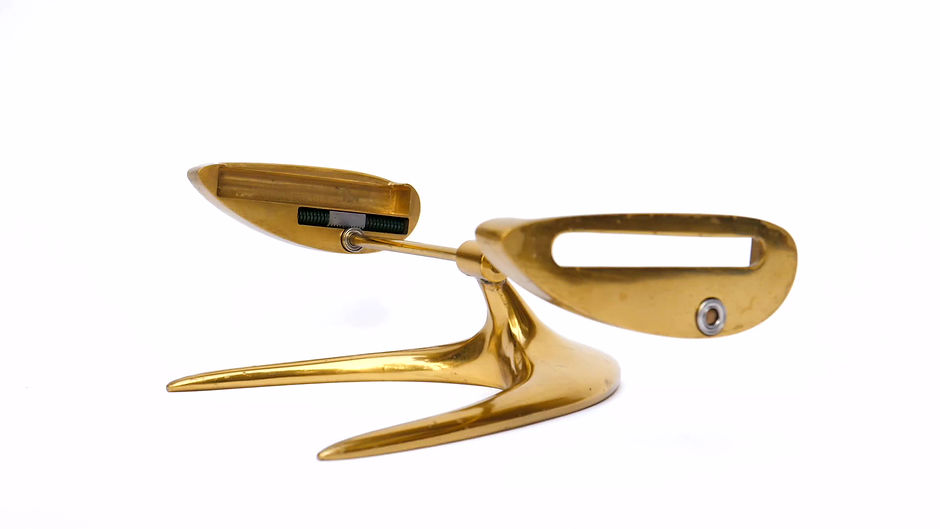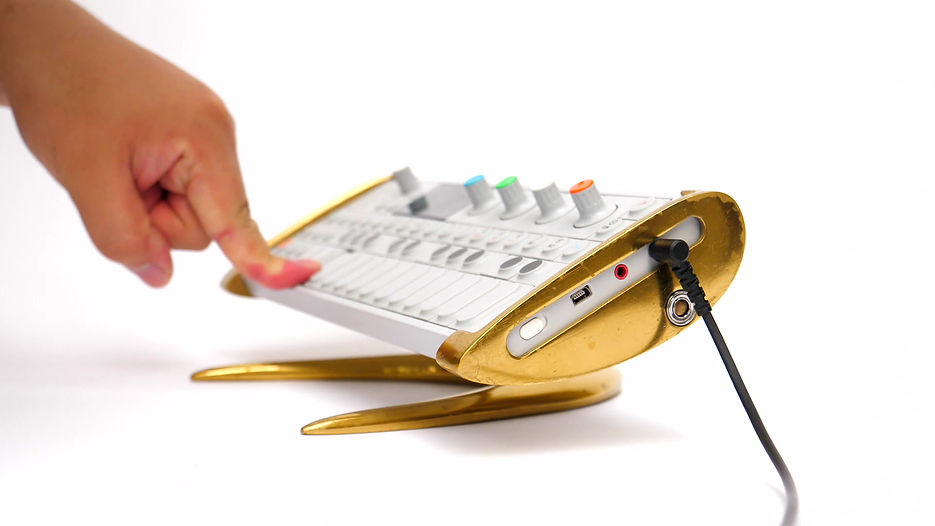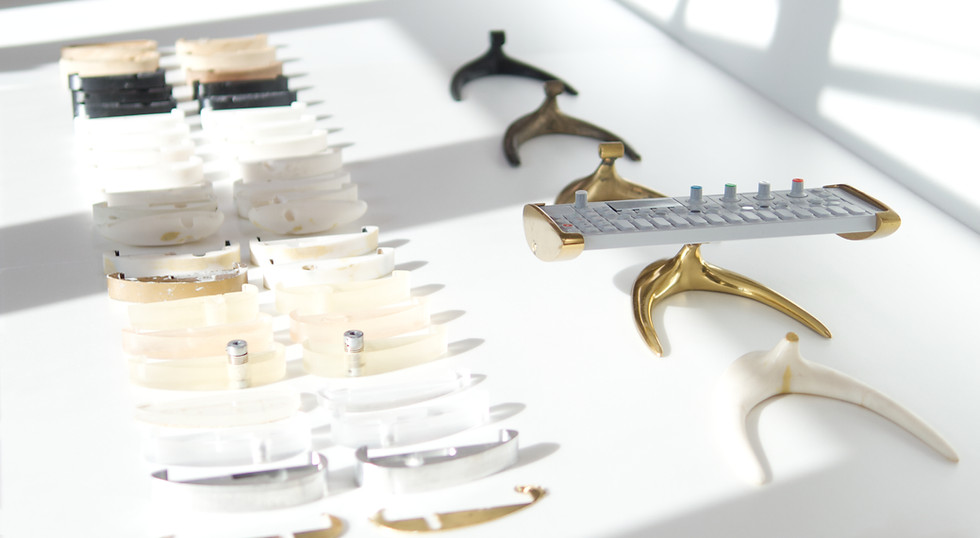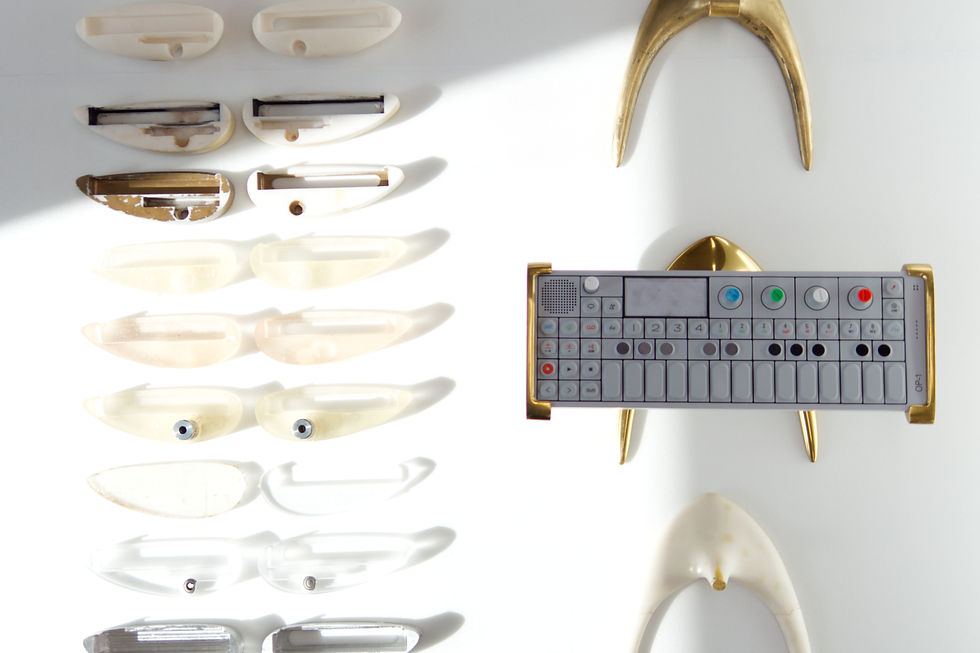SUNGJUNYU

GRAVITY STAND FOR OP-1 / Mechanical stand-interface for digital sensor control
The Gravity Stand for OP-1 is a third-party accessory designed for the synthesizer OP-1 by Teenage Engineering. It not only enhances the usability of its sensor for sound control but also fosters a deeper emotional bond between the digital instrument and the user, elevating the value of the OP-1 from an electronic device to a well-crafted design work.
Year
2019
Keywords
Mechanical Design Engineering
Ergonomic Interface
Sound Interaction

ERGONOMIC DESIGN ENGINEERING FOR INTUITIVE INTERACTION
A core function of the Gravity Stand is its mechanical tilting feature, which maximizes the usability of the OP-1’s G-force sensor control. This works through a sophisticated mechanical structure with springs and gears, allowing the stand to respond seamlessly when the user tilts it. This interaction enables accurate control over parameters such as pitch, volume, effects, and modulation by adjusting the angle. The stand is designed to automatically return to its original position when not in use, minimizing unintended parametric changes. Users experience enhanced physical interaction and haptic feedback through this intuitive, ergonomic interface, making sound manipulation enjoyable.

How does it work?

Sound control using the Gravity Stand for OP-1 >>>
The stand has an angle-adjustable structure that allows for detailed control of the pitch, effect, volume, and modulation of the sound using the OP-1's G-Froce sensor function. The stand has a spring mechanism and the ability to return to its original position even after adjusting the tilt.

USER TEST - CREATING AN EMOTIONAL CONNECTION WITH THE PRODUCT
Delicately handcrafted traditional instruments like violins or pianos tend to increase in value over time and reinforce a sentimental bond with their users. In contrast, most electronic instruments quickly become outdated and lose their value. The Gravity Stand addresses this issue by transforming the OP-1 into a crafted design piece. This allows users to perceive the OP-1 not just as an electronic device but as a valuable work of design, encouraging them to love and care for the instrument more deeply. This approach reflects a philosophy of building a sustainable and meaningful relationship between the user and the product.
Most of the audience who observed the Gravity Stand with OP-1 remarked that the product seemed to exist somewhere between a musical instrument and an artwork. In particular, those who directly operated the stand’s tilting mechanism and held the product in their hands evaluated its value more highly than those who only viewed it in their eyes. It made me wonder whether tactile interaction could make users develop a deeper affection for the product.
BACKGROUND
The primary purpose of designing this stand came from discussions with other musicians who use the OP-1. One of the main issues they pointed out was the difficulty of using the OP-1’s G-force sensor during performances. To activate the sensor, the player must physically lift and move it, which disrupts the playing. This led me to design an ergonomic accessory to address this issue.
Beyond its functional purpose, this project also incorporates a design approach from a sustainability, emotional design perspective. I asked myself, How can electronics like synthesizers inspire users to develop a deeper emotional connection and assign more value to them? This question became a key focus of the project.
The idea was sparked by an old interview with musician Noel, who said, “If you find after five years you can’t play your instrument, so what? Stick it on a stand in the corner. It’ll look good.” This saying inspired me and made me think about how a product could enhance usability and foster a stronger emotional bond with its users.
From this perspective, my approach was to create an ergonomic stand that transforms the OP-1 into a piece of art. The stand’s form was heavily inspired by Bird in Space, my favourite artwork by Constantin Brancuși, which served as a key reference point. These inspirations guided me in designing a project that combines functionality and artistic expression.

Take it away (2010, July 22). Noel Gallagher talks to Take it away [Video]. YouTube.
https://www.youtube.com/watch?v=3PcMNyefs5E
PROTOTYPING
This project focused not only on the functional aspects of the stand but also on fostering a meaningful connection between the product and its users. To achieve this, extensive effort was devoted to refining the stand’s colour, material, and finish (CMF), while prioritizing a seamless tactile experience in use. Over 60 mechanical prototypes were built to perfect the mechanical structure. Additionally, mock-ups were made using various woods and metals to explore the sensory qualities of different finishes. Ultimately, brass was chosen for its exceptional performance in terms of CMF and overall user satisfaction. Its high density compared to other metals provided outstanding stability and a satisfying weightiness that enhanced the product’s seamless feel.

